Finance for Business: K2fly Limited Financial Performance Analysis
VerifiedAdded on 2020/05/16
|13
|2409
|30
Report
AI Summary
This report provides a comprehensive financial analysis of K2fly Limited, an Australian asset management technology company. It examines the company's description, ownership structure, and key personnel. The report delves into key financial ratios such as Return on Assets (ROA), Debt Ratio, and Return on Equity (ROE), providing insights into their implications for management decisions. It analyzes stock movement data from the ASX website, including monthly adjusted closing prices and the All Ordinary Index, to assess stock volatility and correlation. The report calculates the company's beta and discusses its implications for conservative investment strategies. Furthermore, it computes the Weighted Average Cost of Capital (WACC) and explores the optimal debt structure, including gearing ratios. The dividend policy is reviewed, and ultimately, a recommendation is provided regarding the inclusion of K2fly Limited stock in a portfolio, considering its performance and risk profile. The analysis is supported by references to relevant financial literature.
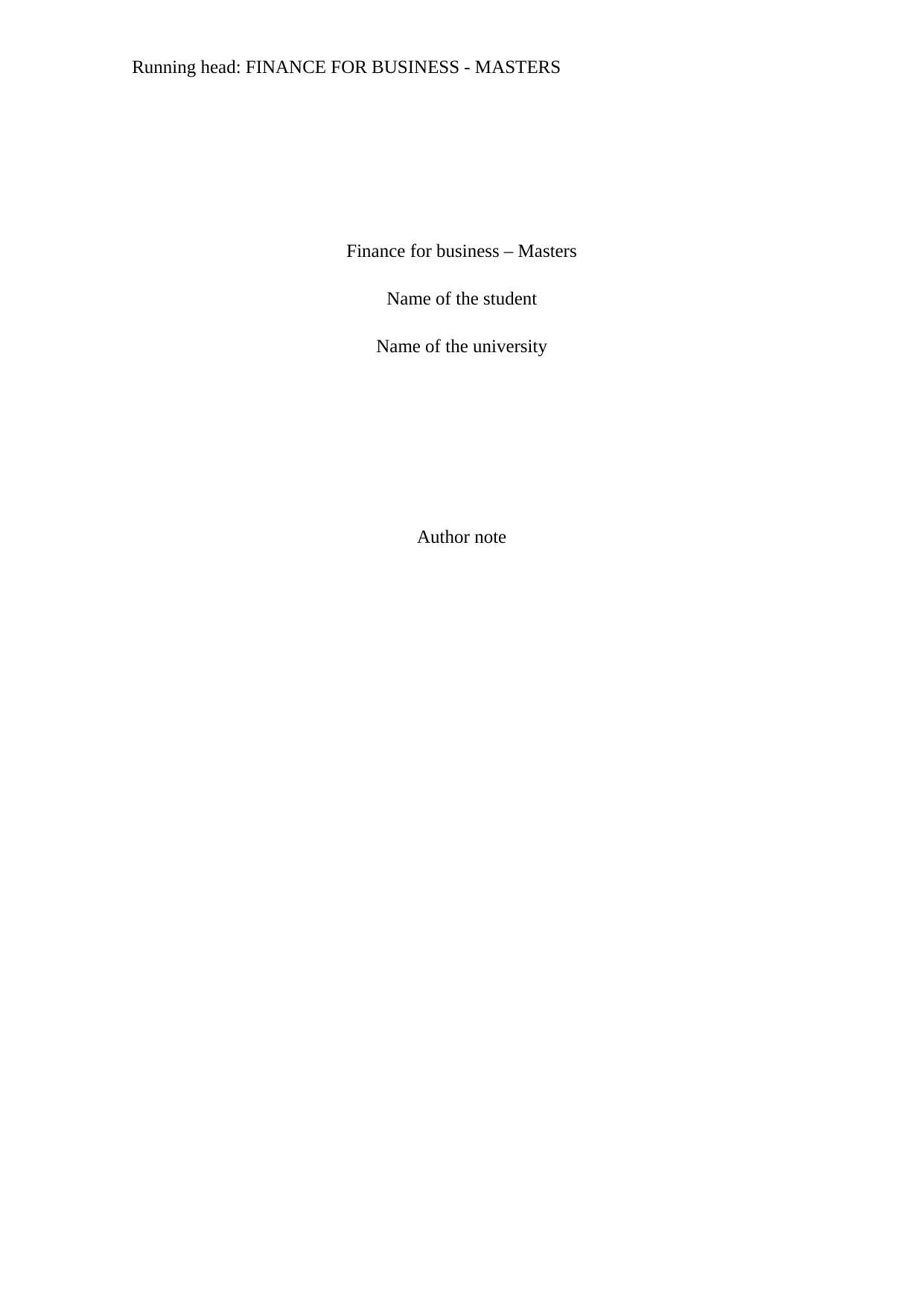
Running head: FINANCE FOR BUSINESS - MASTERS
Finance for business – Masters
Name of the student
Name of the university
Author note
Finance for business – Masters
Name of the student
Name of the university
Author note
Paraphrase This Document
Need a fresh take? Get an instant paraphrase of this document with our AI Paraphraser

FINANCE FOR BUSINESS – MASTERS 1
Table of Contents
1. Company description.................................................................................................2
2. Ownership structure...................................................................................................2
3. Key ratios...................................................................................................................2
4. Information from ASX website..................................................................................4
5. Recent announcement................................................................................................7
6. Stock field..................................................................................................................7
7. WACC (weighted average cost of capital).................................................................7
8. Optimal debt structure................................................................................................8
9. Dividend policy..........................................................................................................9
10. Recommendation..................................................................................................10
Reference.........................................................................................................................11
Table of Contents
1. Company description.................................................................................................2
2. Ownership structure...................................................................................................2
3. Key ratios...................................................................................................................2
4. Information from ASX website..................................................................................4
5. Recent announcement................................................................................................7
6. Stock field..................................................................................................................7
7. WACC (weighted average cost of capital).................................................................7
8. Optimal debt structure................................................................................................8
9. Dividend policy..........................................................................................................9
10. Recommendation..................................................................................................10
Reference.........................................................................................................................11
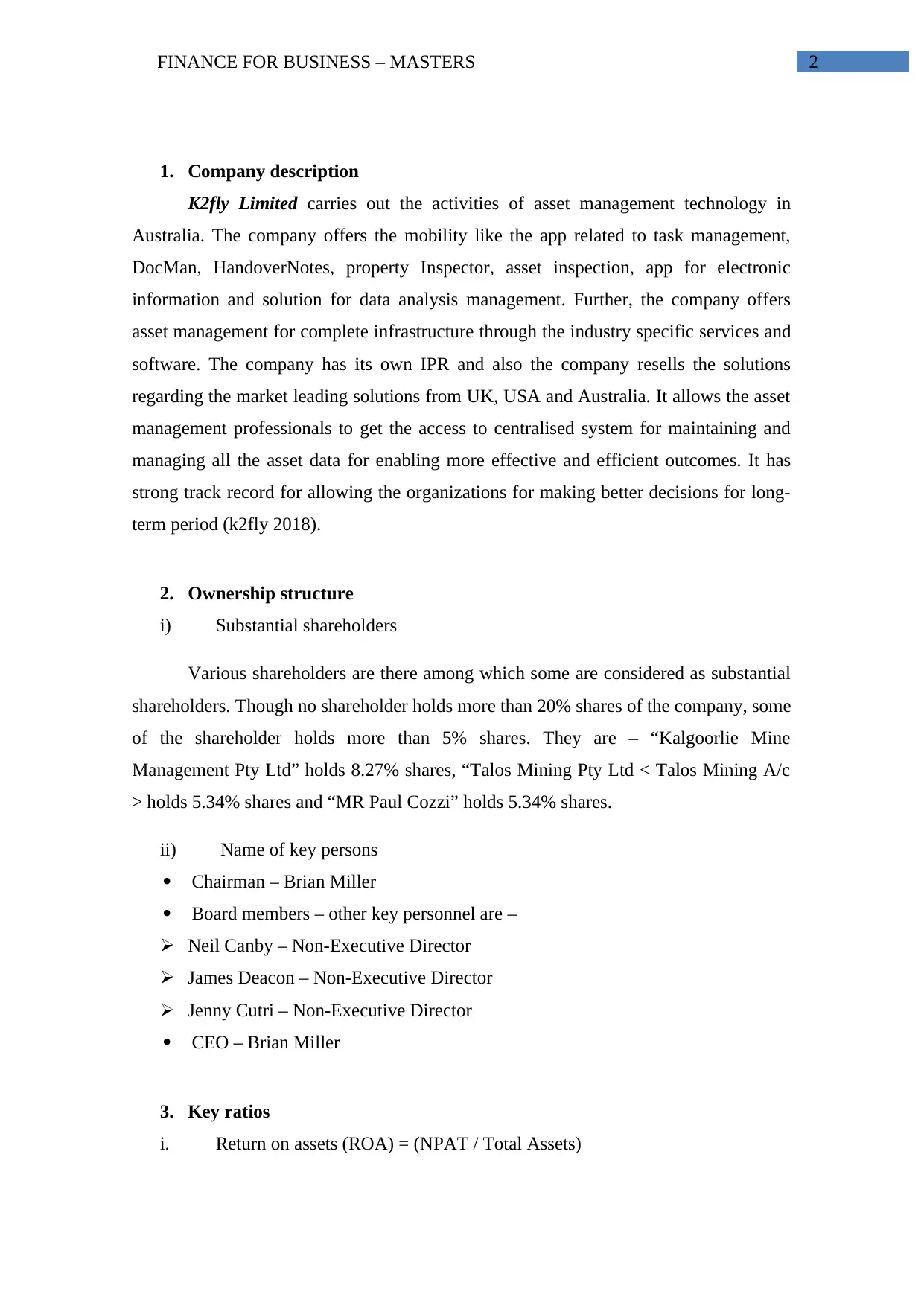
FINANCE FOR BUSINESS – MASTERS 2
1. Company description
K2fly Limited carries out the activities of asset management technology in
Australia. The company offers the mobility like the app related to task management,
DocMan, HandoverNotes, property Inspector, asset inspection, app for electronic
information and solution for data analysis management. Further, the company offers
asset management for complete infrastructure through the industry specific services and
software. The company has its own IPR and also the company resells the solutions
regarding the market leading solutions from UK, USA and Australia. It allows the asset
management professionals to get the access to centralised system for maintaining and
managing all the asset data for enabling more effective and efficient outcomes. It has
strong track record for allowing the organizations for making better decisions for long-
term period (k2fly 2018).
2. Ownership structure
i) Substantial shareholders
Various shareholders are there among which some are considered as substantial
shareholders. Though no shareholder holds more than 20% shares of the company, some
of the shareholder holds more than 5% shares. They are – “Kalgoorlie Mine
Management Pty Ltd” holds 8.27% shares, “Talos Mining Pty Ltd < Talos Mining A/c
> holds 5.34% shares and “MR Paul Cozzi” holds 5.34% shares.
ii) Name of key persons
Chairman – Brian Miller
Board members – other key personnel are –
Neil Canby – Non-Executive Director
James Deacon – Non-Executive Director
Jenny Cutri – Non-Executive Director
CEO – Brian Miller
3. Key ratios
i. Return on assets (ROA) = (NPAT / Total Assets)
1. Company description
K2fly Limited carries out the activities of asset management technology in
Australia. The company offers the mobility like the app related to task management,
DocMan, HandoverNotes, property Inspector, asset inspection, app for electronic
information and solution for data analysis management. Further, the company offers
asset management for complete infrastructure through the industry specific services and
software. The company has its own IPR and also the company resells the solutions
regarding the market leading solutions from UK, USA and Australia. It allows the asset
management professionals to get the access to centralised system for maintaining and
managing all the asset data for enabling more effective and efficient outcomes. It has
strong track record for allowing the organizations for making better decisions for long-
term period (k2fly 2018).
2. Ownership structure
i) Substantial shareholders
Various shareholders are there among which some are considered as substantial
shareholders. Though no shareholder holds more than 20% shares of the company, some
of the shareholder holds more than 5% shares. They are – “Kalgoorlie Mine
Management Pty Ltd” holds 8.27% shares, “Talos Mining Pty Ltd < Talos Mining A/c
> holds 5.34% shares and “MR Paul Cozzi” holds 5.34% shares.
ii) Name of key persons
Chairman – Brian Miller
Board members – other key personnel are –
Neil Canby – Non-Executive Director
James Deacon – Non-Executive Director
Jenny Cutri – Non-Executive Director
CEO – Brian Miller
3. Key ratios
i. Return on assets (ROA) = (NPAT / Total Assets)
⊘ This is a preview!⊘
Do you want full access?
Subscribe today to unlock all pages.

Trusted by 1+ million students worldwide
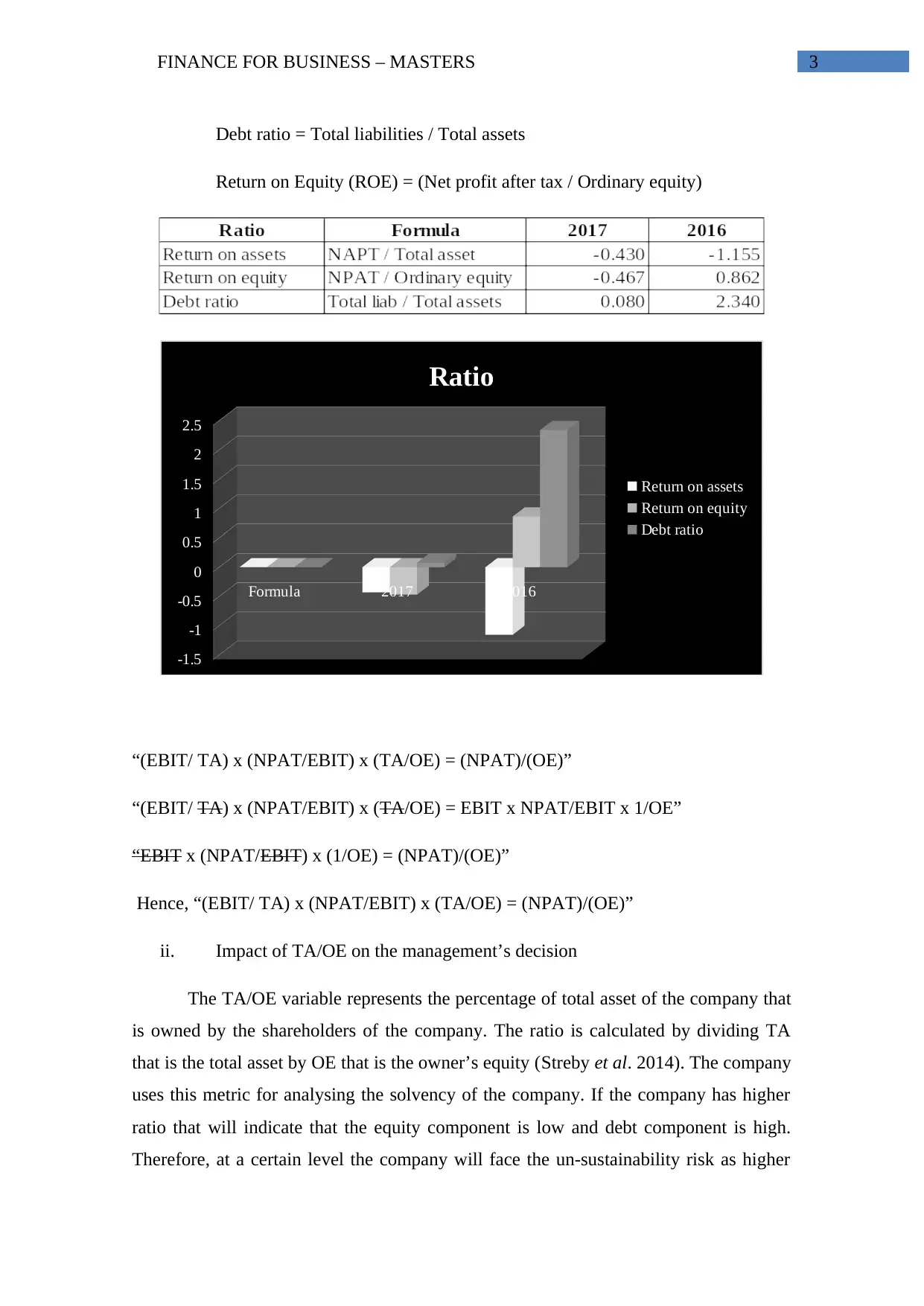
FINANCE FOR BUSINESS – MASTERS 3
Debt ratio = Total liabilities / Total assets
Return on Equity (ROE) = (Net profit after tax / Ordinary equity)
Formula 2017 2016
-1.5
-1
-0.5
0
0.5
1
1.5
2
2.5
Ratio
Return on assets
Return on equity
Debt ratio
“(EBIT/ TA) x (NPAT/EBIT) x (TA/OE) = (NPAT)/(OE)”
“(EBIT/ TA) x (NPAT/EBIT) x (TA/OE) = EBIT x NPAT/EBIT x 1/OE”
“EBIT x (NPAT/EBIT) x (1/OE) = (NPAT)/(OE)”
Hence, “(EBIT/ TA) x (NPAT/EBIT) x (TA/OE) = (NPAT)/(OE)”
ii. Impact of TA/OE on the management’s decision
The TA/OE variable represents the percentage of total asset of the company that
is owned by the shareholders of the company. The ratio is calculated by dividing TA
that is the total asset by OE that is the owner’s equity (Streby et al. 2014). The company
uses this metric for analysing the solvency of the company. If the company has higher
ratio that will indicate that the equity component is low and debt component is high.
Therefore, at a certain level the company will face the un-sustainability risk as higher
Debt ratio = Total liabilities / Total assets
Return on Equity (ROE) = (Net profit after tax / Ordinary equity)
Formula 2017 2016
-1.5
-1
-0.5
0
0.5
1
1.5
2
2.5
Ratio
Return on assets
Return on equity
Debt ratio
“(EBIT/ TA) x (NPAT/EBIT) x (TA/OE) = (NPAT)/(OE)”
“(EBIT/ TA) x (NPAT/EBIT) x (TA/OE) = EBIT x NPAT/EBIT x 1/OE”
“EBIT x (NPAT/EBIT) x (1/OE) = (NPAT)/(OE)”
Hence, “(EBIT/ TA) x (NPAT/EBIT) x (TA/OE) = (NPAT)/(OE)”
ii. Impact of TA/OE on the management’s decision
The TA/OE variable represents the percentage of total asset of the company that
is owned by the shareholders of the company. The ratio is calculated by dividing TA
that is the total asset by OE that is the owner’s equity (Streby et al. 2014). The company
uses this metric for analysing the solvency of the company. If the company has higher
ratio that will indicate that the equity component is low and debt component is high.
Therefore, at a certain level the company will face the un-sustainability risk as higher
Paraphrase This Document
Need a fresh take? Get an instant paraphrase of this document with our AI Paraphraser
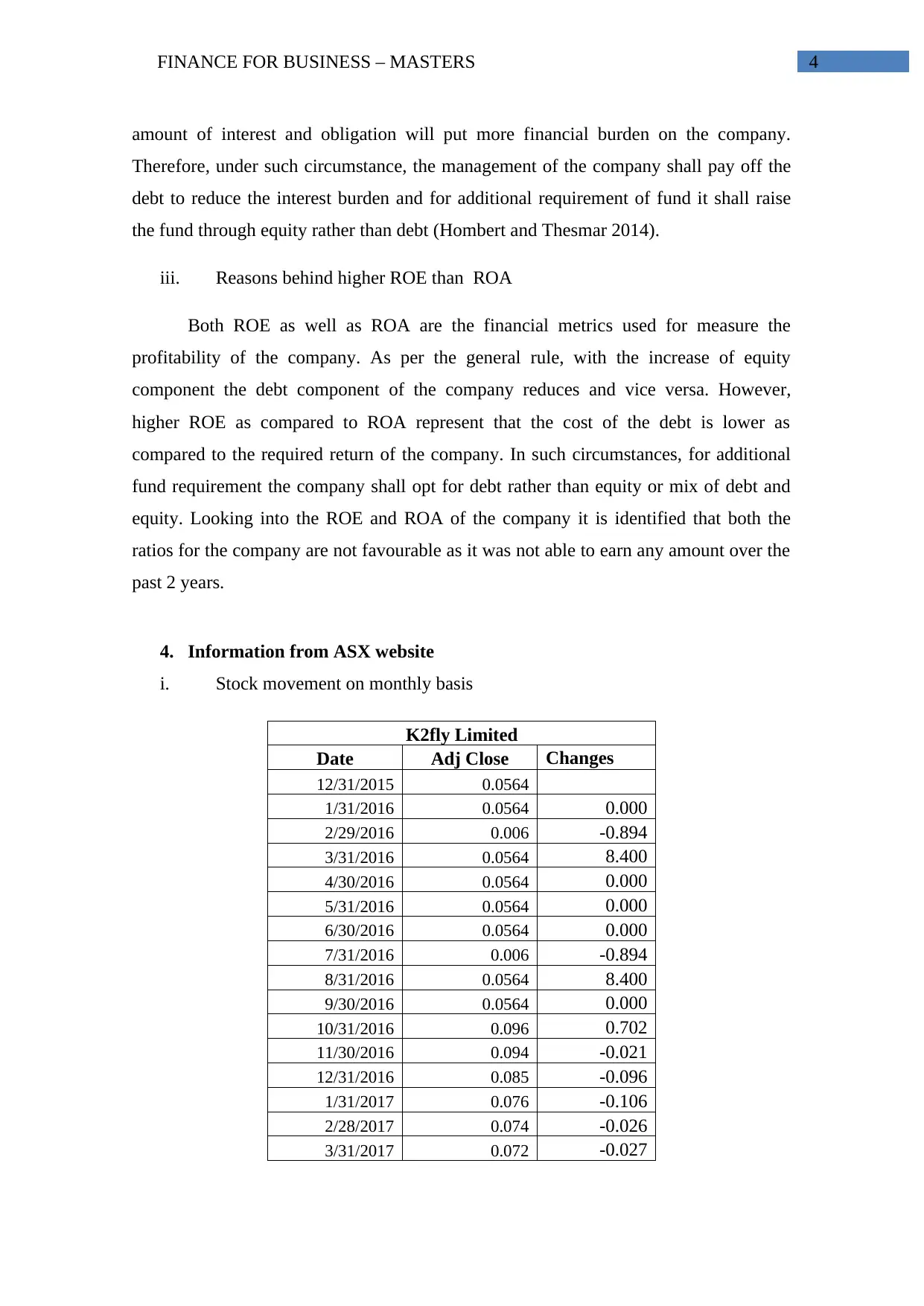
FINANCE FOR BUSINESS – MASTERS 4
amount of interest and obligation will put more financial burden on the company.
Therefore, under such circumstance, the management of the company shall pay off the
debt to reduce the interest burden and for additional requirement of fund it shall raise
the fund through equity rather than debt (Hombert and Thesmar 2014).
iii. Reasons behind higher ROE than ROA
Both ROE as well as ROA are the financial metrics used for measure the
profitability of the company. As per the general rule, with the increase of equity
component the debt component of the company reduces and vice versa. However,
higher ROE as compared to ROA represent that the cost of the debt is lower as
compared to the required return of the company. In such circumstances, for additional
fund requirement the company shall opt for debt rather than equity or mix of debt and
equity. Looking into the ROE and ROA of the company it is identified that both the
ratios for the company are not favourable as it was not able to earn any amount over the
past 2 years.
4. Information from ASX website
i. Stock movement on monthly basis
K2fly Limited
Date Adj Close Changes
12/31/2015 0.0564
1/31/2016 0.0564 0.000
2/29/2016 0.006 -0.894
3/31/2016 0.0564 8.400
4/30/2016 0.0564 0.000
5/31/2016 0.0564 0.000
6/30/2016 0.0564 0.000
7/31/2016 0.006 -0.894
8/31/2016 0.0564 8.400
9/30/2016 0.0564 0.000
10/31/2016 0.096 0.702
11/30/2016 0.094 -0.021
12/31/2016 0.085 -0.096
1/31/2017 0.076 -0.106
2/28/2017 0.074 -0.026
3/31/2017 0.072 -0.027
amount of interest and obligation will put more financial burden on the company.
Therefore, under such circumstance, the management of the company shall pay off the
debt to reduce the interest burden and for additional requirement of fund it shall raise
the fund through equity rather than debt (Hombert and Thesmar 2014).
iii. Reasons behind higher ROE than ROA
Both ROE as well as ROA are the financial metrics used for measure the
profitability of the company. As per the general rule, with the increase of equity
component the debt component of the company reduces and vice versa. However,
higher ROE as compared to ROA represent that the cost of the debt is lower as
compared to the required return of the company. In such circumstances, for additional
fund requirement the company shall opt for debt rather than equity or mix of debt and
equity. Looking into the ROE and ROA of the company it is identified that both the
ratios for the company are not favourable as it was not able to earn any amount over the
past 2 years.
4. Information from ASX website
i. Stock movement on monthly basis
K2fly Limited
Date Adj Close Changes
12/31/2015 0.0564
1/31/2016 0.0564 0.000
2/29/2016 0.006 -0.894
3/31/2016 0.0564 8.400
4/30/2016 0.0564 0.000
5/31/2016 0.0564 0.000
6/30/2016 0.0564 0.000
7/31/2016 0.006 -0.894
8/31/2016 0.0564 8.400
9/30/2016 0.0564 0.000
10/31/2016 0.096 0.702
11/30/2016 0.094 -0.021
12/31/2016 0.085 -0.096
1/31/2017 0.076 -0.106
2/28/2017 0.074 -0.026
3/31/2017 0.072 -0.027
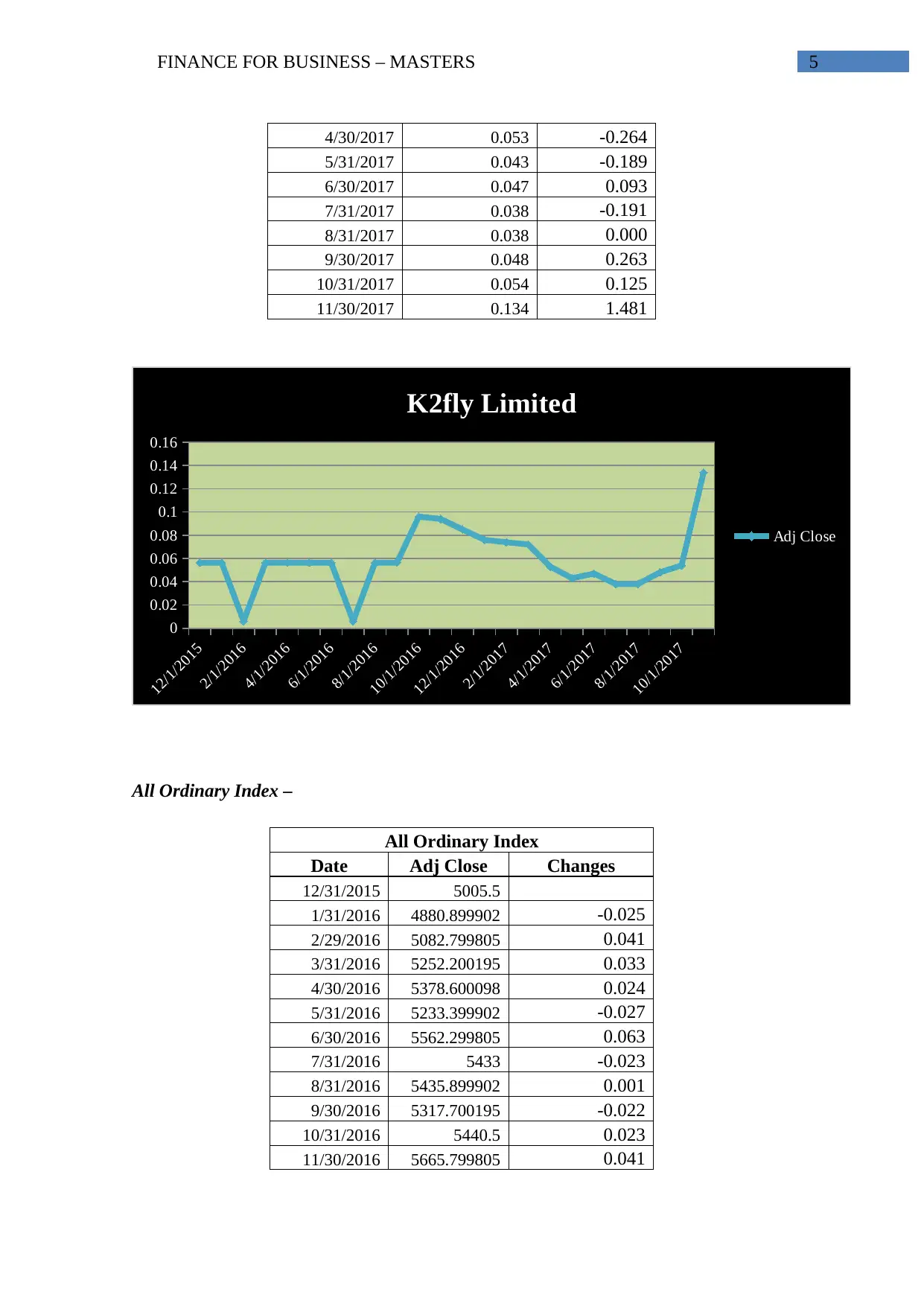
FINANCE FOR BUSINESS – MASTERS 5
4/30/2017 0.053 -0.264
5/31/2017 0.043 -0.189
6/30/2017 0.047 0.093
7/31/2017 0.038 -0.191
8/31/2017 0.038 0.000
9/30/2017 0.048 0.263
10/31/2017 0.054 0.125
11/30/2017 0.134 1.481
12/1/2015
2/1/2016
4/1/2016
6/1/2016
8/1/2016
10/1/2016
12/1/2016
2/1/2017
4/1/2017
6/1/2017
8/1/2017
10/1/2017
0
0.02
0.04
0.06
0.08
0.1
0.12
0.14
0.16
K2fly Limited
Adj Close
All Ordinary Index –
All Ordinary Index
Date Adj Close Changes
12/31/2015 5005.5
1/31/2016 4880.899902 -0.025
2/29/2016 5082.799805 0.041
3/31/2016 5252.200195 0.033
4/30/2016 5378.600098 0.024
5/31/2016 5233.399902 -0.027
6/30/2016 5562.299805 0.063
7/31/2016 5433 -0.023
8/31/2016 5435.899902 0.001
9/30/2016 5317.700195 -0.022
10/31/2016 5440.5 0.023
11/30/2016 5665.799805 0.041
4/30/2017 0.053 -0.264
5/31/2017 0.043 -0.189
6/30/2017 0.047 0.093
7/31/2017 0.038 -0.191
8/31/2017 0.038 0.000
9/30/2017 0.048 0.263
10/31/2017 0.054 0.125
11/30/2017 0.134 1.481
12/1/2015
2/1/2016
4/1/2016
6/1/2016
8/1/2016
10/1/2016
12/1/2016
2/1/2017
4/1/2017
6/1/2017
8/1/2017
10/1/2017
0
0.02
0.04
0.06
0.08
0.1
0.12
0.14
0.16
K2fly Limited
Adj Close
All Ordinary Index –
All Ordinary Index
Date Adj Close Changes
12/31/2015 5005.5
1/31/2016 4880.899902 -0.025
2/29/2016 5082.799805 0.041
3/31/2016 5252.200195 0.033
4/30/2016 5378.600098 0.024
5/31/2016 5233.399902 -0.027
6/30/2016 5562.299805 0.063
7/31/2016 5433 -0.023
8/31/2016 5435.899902 0.001
9/30/2016 5317.700195 -0.022
10/31/2016 5440.5 0.023
11/30/2016 5665.799805 0.041
⊘ This is a preview!⊘
Do you want full access?
Subscribe today to unlock all pages.

Trusted by 1+ million students worldwide
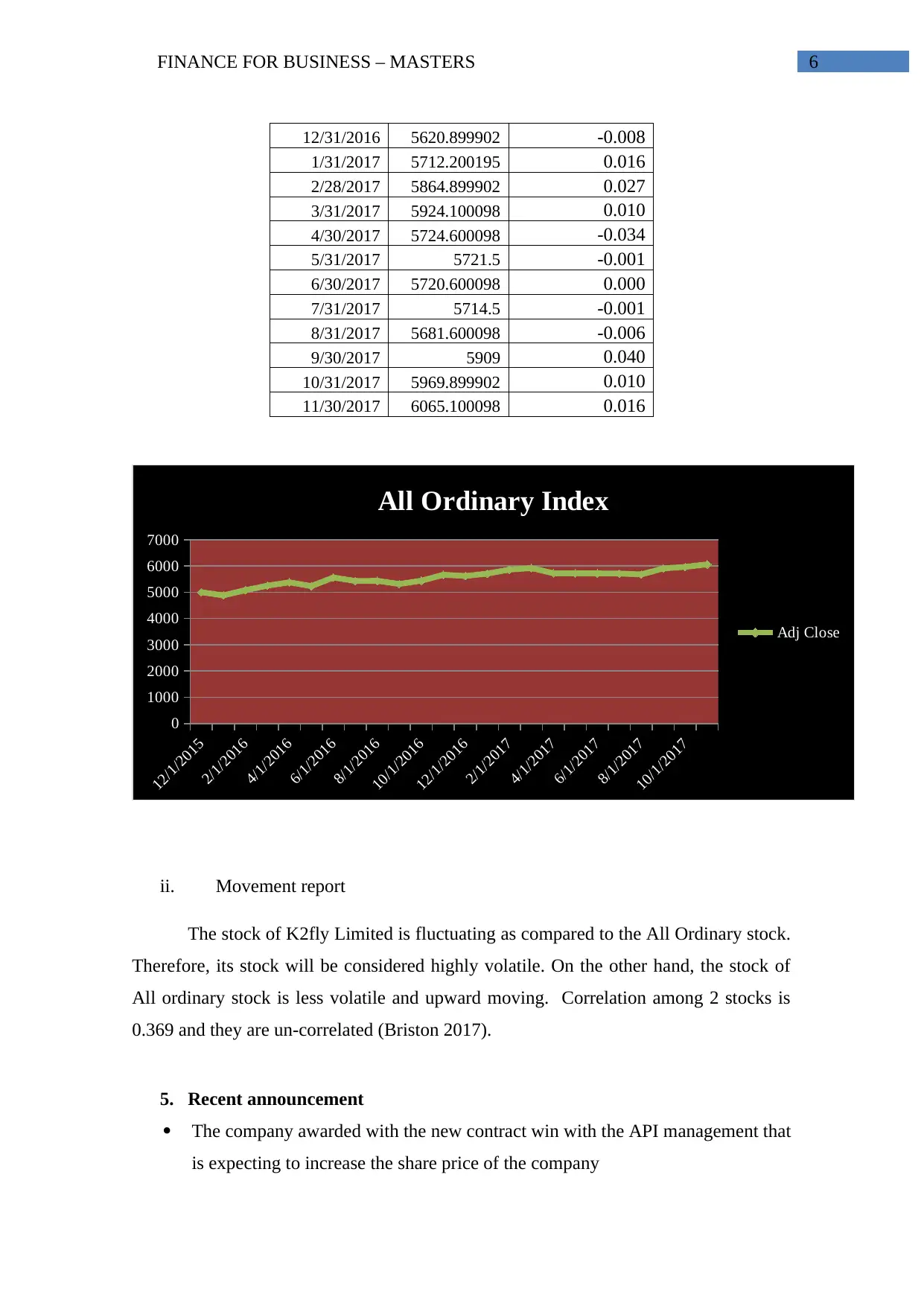
FINANCE FOR BUSINESS – MASTERS 6
12/31/2016 5620.899902 -0.008
1/31/2017 5712.200195 0.016
2/28/2017 5864.899902 0.027
3/31/2017 5924.100098 0.010
4/30/2017 5724.600098 -0.034
5/31/2017 5721.5 -0.001
6/30/2017 5720.600098 0.000
7/31/2017 5714.5 -0.001
8/31/2017 5681.600098 -0.006
9/30/2017 5909 0.040
10/31/2017 5969.899902 0.010
11/30/2017 6065.100098 0.016
12/1/2015
2/1/2016
4/1/2016
6/1/2016
8/1/2016
10/1/2016
12/1/2016
2/1/2017
4/1/2017
6/1/2017
8/1/2017
10/1/2017
0
1000
2000
3000
4000
5000
6000
7000
All Ordinary Index
Adj Close
ii. Movement report
The stock of K2fly Limited is fluctuating as compared to the All Ordinary stock.
Therefore, its stock will be considered highly volatile. On the other hand, the stock of
All ordinary stock is less volatile and upward moving. Correlation among 2 stocks is
0.369 and they are un-correlated (Briston 2017).
5. Recent announcement
The company awarded with the new contract win with the API management that
is expecting to increase the share price of the company
12/31/2016 5620.899902 -0.008
1/31/2017 5712.200195 0.016
2/28/2017 5864.899902 0.027
3/31/2017 5924.100098 0.010
4/30/2017 5724.600098 -0.034
5/31/2017 5721.5 -0.001
6/30/2017 5720.600098 0.000
7/31/2017 5714.5 -0.001
8/31/2017 5681.600098 -0.006
9/30/2017 5909 0.040
10/31/2017 5969.899902 0.010
11/30/2017 6065.100098 0.016
12/1/2015
2/1/2016
4/1/2016
6/1/2016
8/1/2016
10/1/2016
12/1/2016
2/1/2017
4/1/2017
6/1/2017
8/1/2017
10/1/2017
0
1000
2000
3000
4000
5000
6000
7000
All Ordinary Index
Adj Close
ii. Movement report
The stock of K2fly Limited is fluctuating as compared to the All Ordinary stock.
Therefore, its stock will be considered highly volatile. On the other hand, the stock of
All ordinary stock is less volatile and upward moving. Correlation among 2 stocks is
0.369 and they are un-correlated (Briston 2017).
5. Recent announcement
The company awarded with the new contract win with the API management that
is expecting to increase the share price of the company
Paraphrase This Document
Need a fresh take? Get an instant paraphrase of this document with our AI Paraphraser
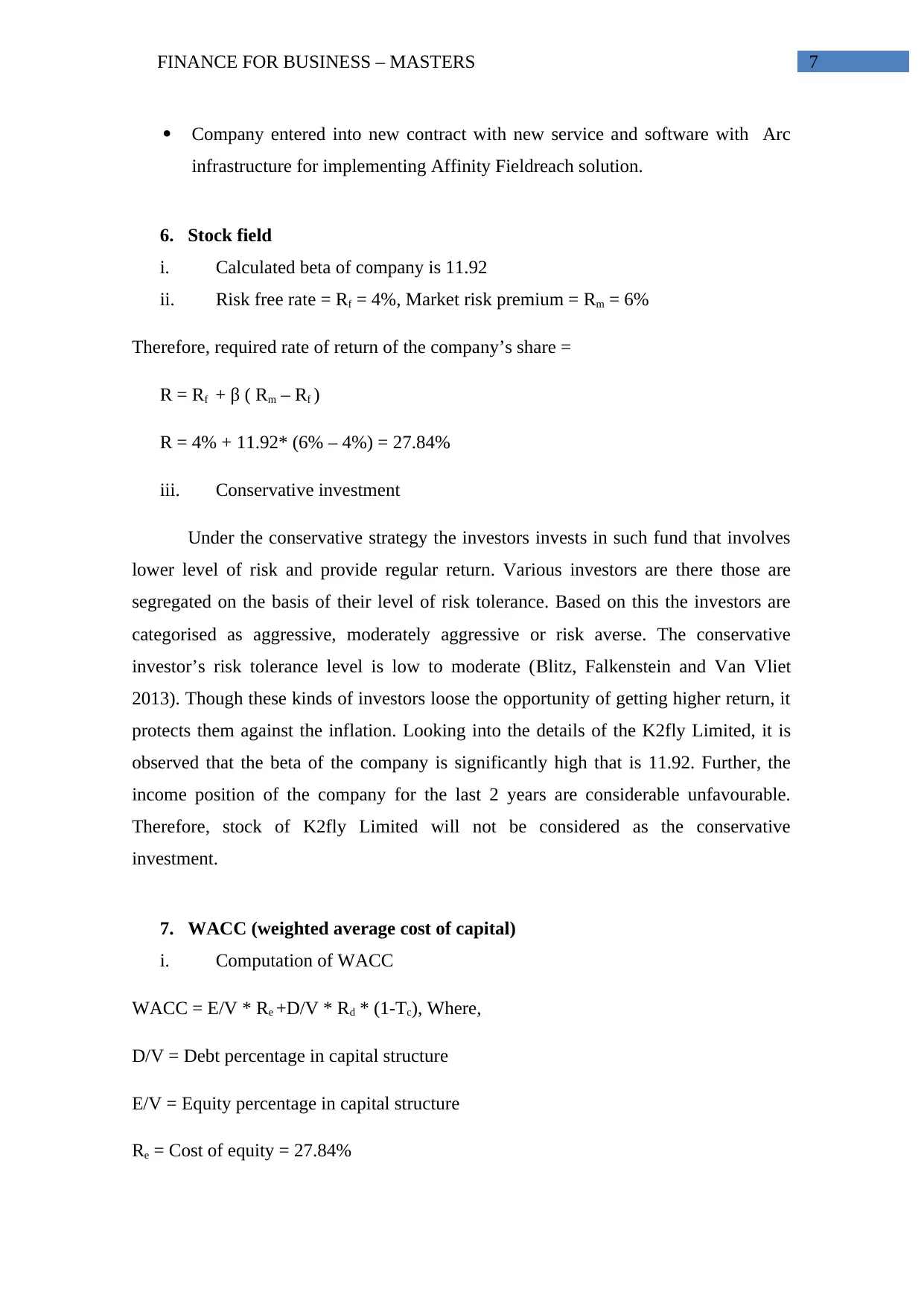
FINANCE FOR BUSINESS – MASTERS 7
Company entered into new contract with new service and software with Arc
infrastructure for implementing Affinity Fieldreach solution.
6. Stock field
i. Calculated beta of company is 11.92
ii. Risk free rate = Rf = 4%, Market risk premium = Rm = 6%
Therefore, required rate of return of the company’s share =
R = Rf + β ( Rm – Rf )
R = 4% + 11.92* (6% – 4%) = 27.84%
iii. Conservative investment
Under the conservative strategy the investors invests in such fund that involves
lower level of risk and provide regular return. Various investors are there those are
segregated on the basis of their level of risk tolerance. Based on this the investors are
categorised as aggressive, moderately aggressive or risk averse. The conservative
investor’s risk tolerance level is low to moderate (Blitz, Falkenstein and Van Vliet
2013). Though these kinds of investors loose the opportunity of getting higher return, it
protects them against the inflation. Looking into the details of the K2fly Limited, it is
observed that the beta of the company is significantly high that is 11.92. Further, the
income position of the company for the last 2 years are considerable unfavourable.
Therefore, stock of K2fly Limited will not be considered as the conservative
investment.
7. WACC (weighted average cost of capital)
i. Computation of WACC
WACC = E/V * Re +D/V * Rd * (1-Tc), Where,
D/V = Debt percentage in capital structure
E/V = Equity percentage in capital structure
Re = Cost of equity = 27.84%
Company entered into new contract with new service and software with Arc
infrastructure for implementing Affinity Fieldreach solution.
6. Stock field
i. Calculated beta of company is 11.92
ii. Risk free rate = Rf = 4%, Market risk premium = Rm = 6%
Therefore, required rate of return of the company’s share =
R = Rf + β ( Rm – Rf )
R = 4% + 11.92* (6% – 4%) = 27.84%
iii. Conservative investment
Under the conservative strategy the investors invests in such fund that involves
lower level of risk and provide regular return. Various investors are there those are
segregated on the basis of their level of risk tolerance. Based on this the investors are
categorised as aggressive, moderately aggressive or risk averse. The conservative
investor’s risk tolerance level is low to moderate (Blitz, Falkenstein and Van Vliet
2013). Though these kinds of investors loose the opportunity of getting higher return, it
protects them against the inflation. Looking into the details of the K2fly Limited, it is
observed that the beta of the company is significantly high that is 11.92. Further, the
income position of the company for the last 2 years are considerable unfavourable.
Therefore, stock of K2fly Limited will not be considered as the conservative
investment.
7. WACC (weighted average cost of capital)
i. Computation of WACC
WACC = E/V * Re +D/V * Rd * (1-Tc), Where,
D/V = Debt percentage in capital structure
E/V = Equity percentage in capital structure
Re = Cost of equity = 27.84%
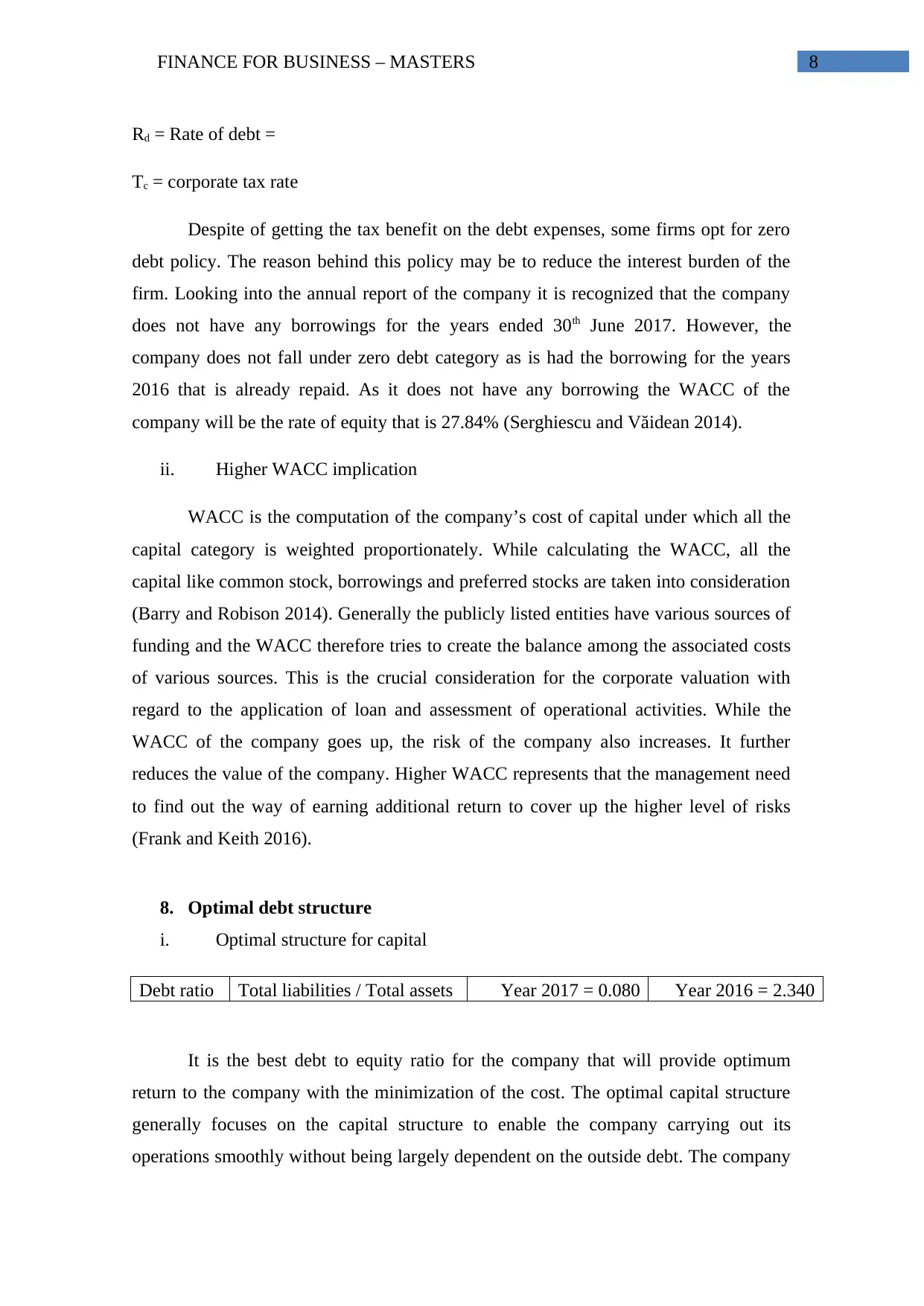
FINANCE FOR BUSINESS – MASTERS 8
Rd = Rate of debt =
Tc = corporate tax rate
Despite of getting the tax benefit on the debt expenses, some firms opt for zero
debt policy. The reason behind this policy may be to reduce the interest burden of the
firm. Looking into the annual report of the company it is recognized that the company
does not have any borrowings for the years ended 30th June 2017. However, the
company does not fall under zero debt category as is had the borrowing for the years
2016 that is already repaid. As it does not have any borrowing the WACC of the
company will be the rate of equity that is 27.84% (Serghiescu and Văidean 2014).
ii. Higher WACC implication
WACC is the computation of the company’s cost of capital under which all the
capital category is weighted proportionately. While calculating the WACC, all the
capital like common stock, borrowings and preferred stocks are taken into consideration
(Barry and Robison 2014). Generally the publicly listed entities have various sources of
funding and the WACC therefore tries to create the balance among the associated costs
of various sources. This is the crucial consideration for the corporate valuation with
regard to the application of loan and assessment of operational activities. While the
WACC of the company goes up, the risk of the company also increases. It further
reduces the value of the company. Higher WACC represents that the management need
to find out the way of earning additional return to cover up the higher level of risks
(Frank and Keith 2016).
8. Optimal debt structure
i. Optimal structure for capital
Debt ratio Total liabilities / Total assets Year 2017 = 0.080 Year 2016 = 2.340
It is the best debt to equity ratio for the company that will provide optimum
return to the company with the minimization of the cost. The optimal capital structure
generally focuses on the capital structure to enable the company carrying out its
operations smoothly without being largely dependent on the outside debt. The company
Rd = Rate of debt =
Tc = corporate tax rate
Despite of getting the tax benefit on the debt expenses, some firms opt for zero
debt policy. The reason behind this policy may be to reduce the interest burden of the
firm. Looking into the annual report of the company it is recognized that the company
does not have any borrowings for the years ended 30th June 2017. However, the
company does not fall under zero debt category as is had the borrowing for the years
2016 that is already repaid. As it does not have any borrowing the WACC of the
company will be the rate of equity that is 27.84% (Serghiescu and Văidean 2014).
ii. Higher WACC implication
WACC is the computation of the company’s cost of capital under which all the
capital category is weighted proportionately. While calculating the WACC, all the
capital like common stock, borrowings and preferred stocks are taken into consideration
(Barry and Robison 2014). Generally the publicly listed entities have various sources of
funding and the WACC therefore tries to create the balance among the associated costs
of various sources. This is the crucial consideration for the corporate valuation with
regard to the application of loan and assessment of operational activities. While the
WACC of the company goes up, the risk of the company also increases. It further
reduces the value of the company. Higher WACC represents that the management need
to find out the way of earning additional return to cover up the higher level of risks
(Frank and Keith 2016).
8. Optimal debt structure
i. Optimal structure for capital
Debt ratio Total liabilities / Total assets Year 2017 = 0.080 Year 2016 = 2.340
It is the best debt to equity ratio for the company that will provide optimum
return to the company with the minimization of the cost. The optimal capital structure
generally focuses on the capital structure to enable the company carrying out its
operations smoothly without being largely dependent on the outside debt. The company
⊘ This is a preview!⊘
Do you want full access?
Subscribe today to unlock all pages.

Trusted by 1+ million students worldwide
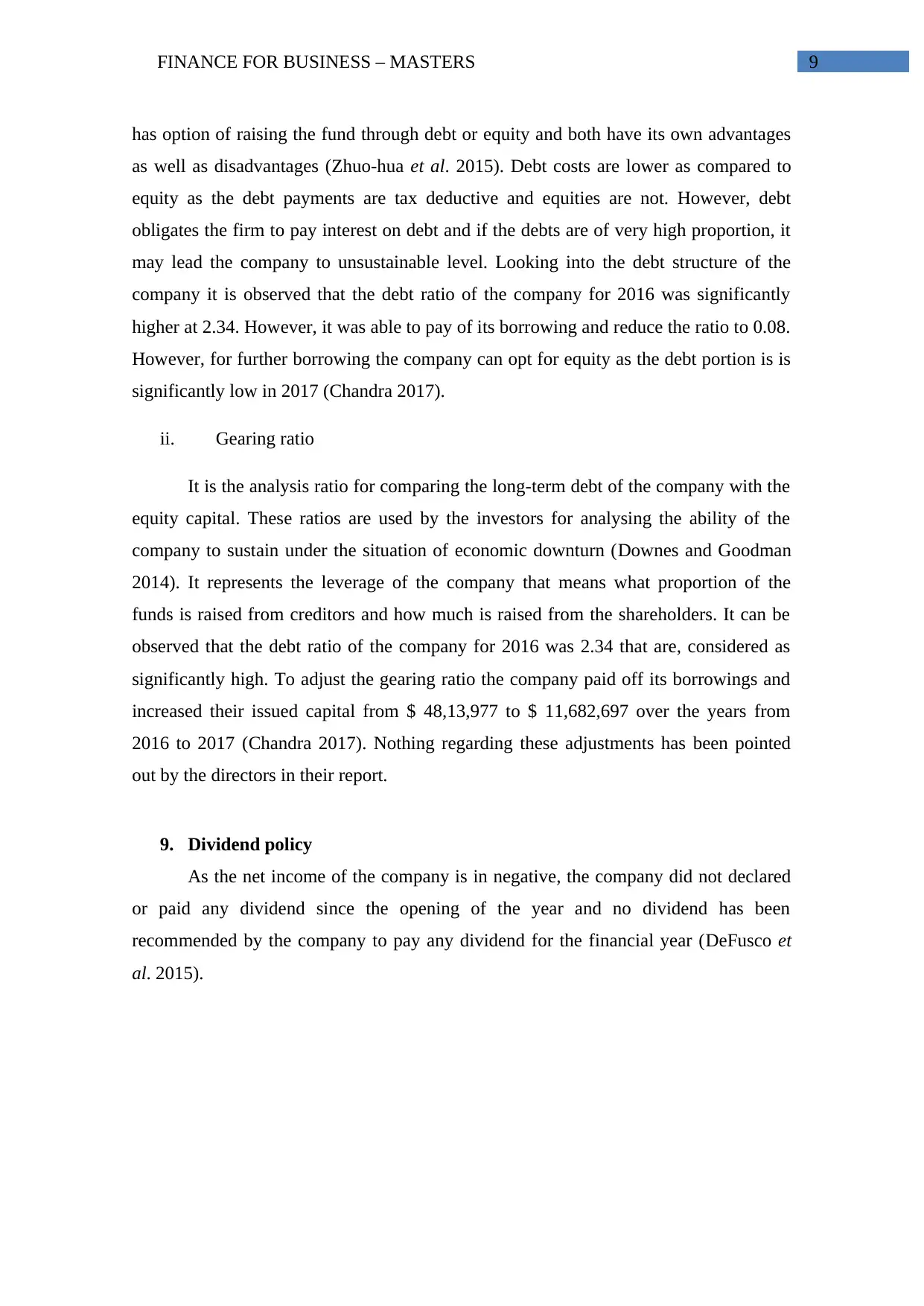
FINANCE FOR BUSINESS – MASTERS 9
has option of raising the fund through debt or equity and both have its own advantages
as well as disadvantages (Zhuo-hua et al. 2015). Debt costs are lower as compared to
equity as the debt payments are tax deductive and equities are not. However, debt
obligates the firm to pay interest on debt and if the debts are of very high proportion, it
may lead the company to unsustainable level. Looking into the debt structure of the
company it is observed that the debt ratio of the company for 2016 was significantly
higher at 2.34. However, it was able to pay of its borrowing and reduce the ratio to 0.08.
However, for further borrowing the company can opt for equity as the debt portion is is
significantly low in 2017 (Chandra 2017).
ii. Gearing ratio
It is the analysis ratio for comparing the long-term debt of the company with the
equity capital. These ratios are used by the investors for analysing the ability of the
company to sustain under the situation of economic downturn (Downes and Goodman
2014). It represents the leverage of the company that means what proportion of the
funds is raised from creditors and how much is raised from the shareholders. It can be
observed that the debt ratio of the company for 2016 was 2.34 that are, considered as
significantly high. To adjust the gearing ratio the company paid off its borrowings and
increased their issued capital from $ 48,13,977 to $ 11,682,697 over the years from
2016 to 2017 (Chandra 2017). Nothing regarding these adjustments has been pointed
out by the directors in their report.
9. Dividend policy
As the net income of the company is in negative, the company did not declared
or paid any dividend since the opening of the year and no dividend has been
recommended by the company to pay any dividend for the financial year (DeFusco et
al. 2015).
has option of raising the fund through debt or equity and both have its own advantages
as well as disadvantages (Zhuo-hua et al. 2015). Debt costs are lower as compared to
equity as the debt payments are tax deductive and equities are not. However, debt
obligates the firm to pay interest on debt and if the debts are of very high proportion, it
may lead the company to unsustainable level. Looking into the debt structure of the
company it is observed that the debt ratio of the company for 2016 was significantly
higher at 2.34. However, it was able to pay of its borrowing and reduce the ratio to 0.08.
However, for further borrowing the company can opt for equity as the debt portion is is
significantly low in 2017 (Chandra 2017).
ii. Gearing ratio
It is the analysis ratio for comparing the long-term debt of the company with the
equity capital. These ratios are used by the investors for analysing the ability of the
company to sustain under the situation of economic downturn (Downes and Goodman
2014). It represents the leverage of the company that means what proportion of the
funds is raised from creditors and how much is raised from the shareholders. It can be
observed that the debt ratio of the company for 2016 was 2.34 that are, considered as
significantly high. To adjust the gearing ratio the company paid off its borrowings and
increased their issued capital from $ 48,13,977 to $ 11,682,697 over the years from
2016 to 2017 (Chandra 2017). Nothing regarding these adjustments has been pointed
out by the directors in their report.
9. Dividend policy
As the net income of the company is in negative, the company did not declared
or paid any dividend since the opening of the year and no dividend has been
recommended by the company to pay any dividend for the financial year (DeFusco et
al. 2015).
Paraphrase This Document
Need a fresh take? Get an instant paraphrase of this document with our AI Paraphraser

FINANCE FOR BUSINESS – MASTERS 10
10. Recommendation
Looking at the unfavourable results of the company with regard to the ROE,
ROA, net income of the company, the client will not be recommended to include the
stock of K2Fly Limited in his portfolio. Further, the risk of the stock that is beta of the
company is 11.92 which is, significantly high.
10. Recommendation
Looking at the unfavourable results of the company with regard to the ROE,
ROA, net income of the company, the client will not be recommended to include the
stock of K2Fly Limited in his portfolio. Further, the risk of the stock that is beta of the
company is 11.92 which is, significantly high.
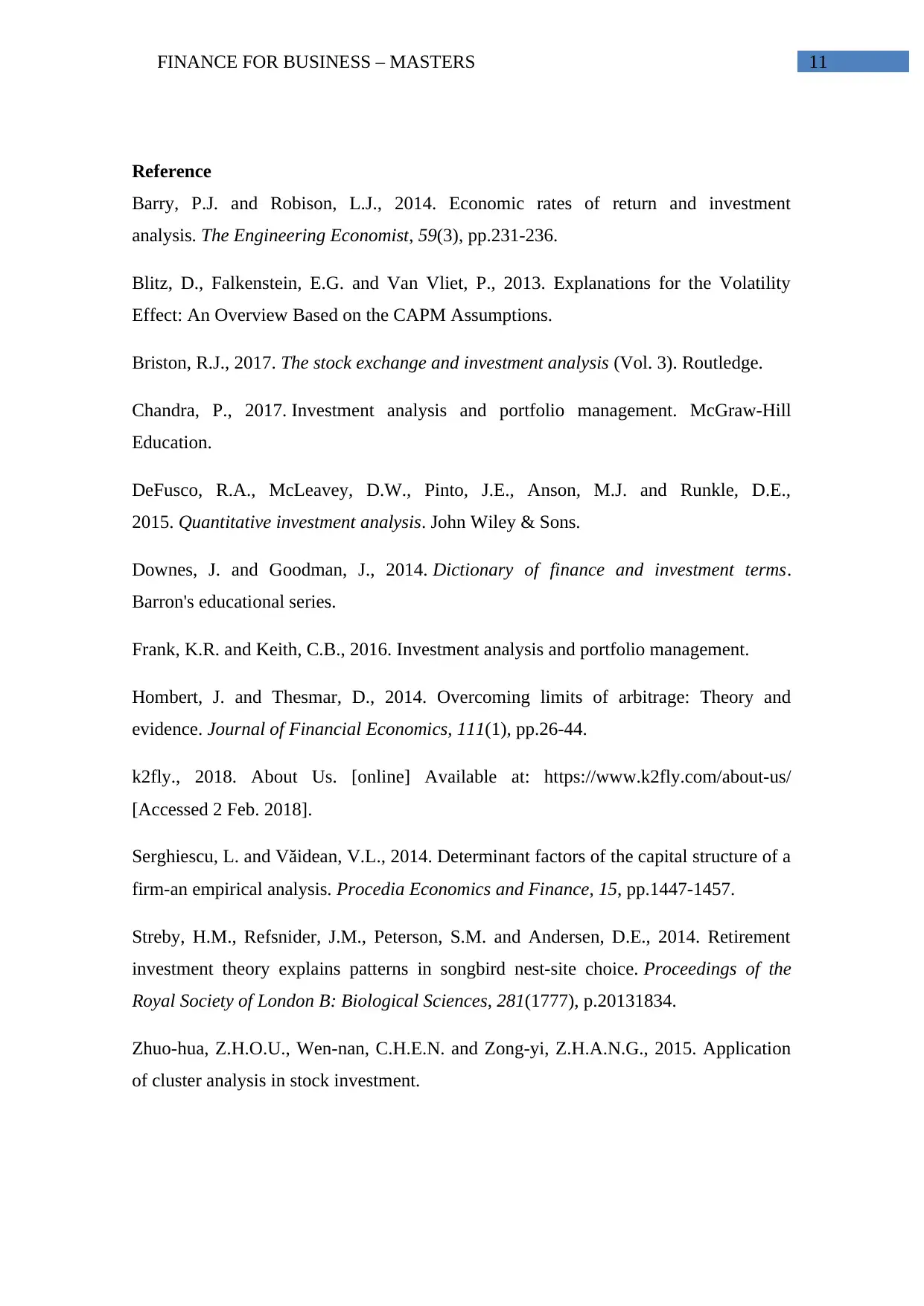
FINANCE FOR BUSINESS – MASTERS 11
Reference
Barry, P.J. and Robison, L.J., 2014. Economic rates of return and investment
analysis. The Engineering Economist, 59(3), pp.231-236.
Blitz, D., Falkenstein, E.G. and Van Vliet, P., 2013. Explanations for the Volatility
Effect: An Overview Based on the CAPM Assumptions.
Briston, R.J., 2017. The stock exchange and investment analysis (Vol. 3). Routledge.
Chandra, P., 2017. Investment analysis and portfolio management. McGraw-Hill
Education.
DeFusco, R.A., McLeavey, D.W., Pinto, J.E., Anson, M.J. and Runkle, D.E.,
2015. Quantitative investment analysis. John Wiley & Sons.
Downes, J. and Goodman, J., 2014. Dictionary of finance and investment terms.
Barron's educational series.
Frank, K.R. and Keith, C.B., 2016. Investment analysis and portfolio management.
Hombert, J. and Thesmar, D., 2014. Overcoming limits of arbitrage: Theory and
evidence. Journal of Financial Economics, 111(1), pp.26-44.
k2fly., 2018. About Us. [online] Available at: https://www.k2fly.com/about-us/
[Accessed 2 Feb. 2018].
Serghiescu, L. and Văidean, V.L., 2014. Determinant factors of the capital structure of a
firm-an empirical analysis. Procedia Economics and Finance, 15, pp.1447-1457.
Streby, H.M., Refsnider, J.M., Peterson, S.M. and Andersen, D.E., 2014. Retirement
investment theory explains patterns in songbird nest-site choice. Proceedings of the
Royal Society of London B: Biological Sciences, 281(1777), p.20131834.
Zhuo-hua, Z.H.O.U., Wen-nan, C.H.E.N. and Zong-yi, Z.H.A.N.G., 2015. Application
of cluster analysis in stock investment.
Reference
Barry, P.J. and Robison, L.J., 2014. Economic rates of return and investment
analysis. The Engineering Economist, 59(3), pp.231-236.
Blitz, D., Falkenstein, E.G. and Van Vliet, P., 2013. Explanations for the Volatility
Effect: An Overview Based on the CAPM Assumptions.
Briston, R.J., 2017. The stock exchange and investment analysis (Vol. 3). Routledge.
Chandra, P., 2017. Investment analysis and portfolio management. McGraw-Hill
Education.
DeFusco, R.A., McLeavey, D.W., Pinto, J.E., Anson, M.J. and Runkle, D.E.,
2015. Quantitative investment analysis. John Wiley & Sons.
Downes, J. and Goodman, J., 2014. Dictionary of finance and investment terms.
Barron's educational series.
Frank, K.R. and Keith, C.B., 2016. Investment analysis and portfolio management.
Hombert, J. and Thesmar, D., 2014. Overcoming limits of arbitrage: Theory and
evidence. Journal of Financial Economics, 111(1), pp.26-44.
k2fly., 2018. About Us. [online] Available at: https://www.k2fly.com/about-us/
[Accessed 2 Feb. 2018].
Serghiescu, L. and Văidean, V.L., 2014. Determinant factors of the capital structure of a
firm-an empirical analysis. Procedia Economics and Finance, 15, pp.1447-1457.
Streby, H.M., Refsnider, J.M., Peterson, S.M. and Andersen, D.E., 2014. Retirement
investment theory explains patterns in songbird nest-site choice. Proceedings of the
Royal Society of London B: Biological Sciences, 281(1777), p.20131834.
Zhuo-hua, Z.H.O.U., Wen-nan, C.H.E.N. and Zong-yi, Z.H.A.N.G., 2015. Application
of cluster analysis in stock investment.
⊘ This is a preview!⊘
Do you want full access?
Subscribe today to unlock all pages.

Trusted by 1+ million students worldwide
1 out of 13
Related Documents
Your All-in-One AI-Powered Toolkit for Academic Success.
+13062052269
info@desklib.com
Available 24*7 on WhatsApp / Email
![[object Object]](/_next/static/media/star-bottom.7253800d.svg)
Unlock your academic potential
Copyright © 2020–2025 A2Z Services. All Rights Reserved. Developed and managed by ZUCOL.





